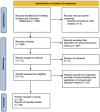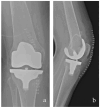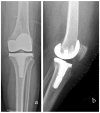Medial Congruent and Medial Pivot Inserts in Total Knee Arthroplasty: A Scoping Review
- PMID: 40428802
- PMCID: PMC12113639
- DOI: 10.3390/medicina61050844
Medial Congruent and Medial Pivot Inserts in Total Knee Arthroplasty: A Scoping Review
Abstract
Background and Objectives: Total knee arthroplasty (TKA) is one of the most common medical procedures worldwide. However, 10 to 20% of patients are still dissatisfied despite implants and surgical technique advancements. Recently, several medial-stabilized TKAs have been developed in attempts to replicate the native kinematics of the knee. The aim of this scoping review on medial-stabilized TKA inserts-medial congruent (MC) and medial pivot (MP)-is to focus on their clinical outcomes and the role of the posterior cruciate ligament (PCL), aiming to systematically map the existing research and highlight current knowledge gaps. Materials and Methods: A search of the PubMed, Embase and Cochrane databases was performed to identify relevant studies on the kinematics and outcomes of medial pivot (MP) or medial congruent (MC) inserts. The following Mesh terms were used in combination with the Boolean operators "AND" and "OR": "total knee arthroplasty", "total knee replacement", "medial pivot", "medial congruence", "outcomes" and "kinematic". Original studies reporting on clinical outcomes assessed with validated patient-reported scales, surgical techniques and reoperation rates for any reason with a minimum follow-up of 18 months were included. Results: A total of 39 articles met the inclusion criteria, accounting for 6143 total knee replacements. The overall reoperation-free survivorship rate was 98.4% (6047 out of 6143 knees) at a weighted average follow-up of 6.3 years (range 1.5-15.2 years, SD 0.7). Both MP and MC inserts demonstrated good outcomes, with no differences between groups. Few studies evaluated the role of the PCL in MP and MC inserts, with no differences in terms of clinical outcomes between retaining and sacrificing the PCL. Conclusions: MS-TKA demonstrated good outcomes in the literature independently of the specific design (medial pivot or medial congruent). Different possible biases may be present when evaluating the outcomes of these inserts, including different types of alignment and soft tissue balancing philosophies.
Keywords: medial congruence; medial pivot; outcomes; total knee arthroplasty.
Conflict of interest statement
F Romano: no disclosure; R Rossi: Angelini Farmaceutica—paid presenter or speaker; Arthrex, Inc—paid presenter or speaker; DePuy A Johnson & Johnson Company—paid presenter or speaker; Lima corporate—IP royalties; Zimmer—paid consultant, paid presenter or speaker and Commitee Member of Siagascot, European Knee Society, American Knee Society, AAHKS international member; U Cottino: teaching consultant Zimmer Biomet; M Bruzzone teaching consultant Depuy; F Pirato: no disclosure; F Rosso: research grant from Medacta and Commitee member of Siagascot, European Knee Society.
Figures




Similar articles
-
Functional alignment restores native kinematics more consistently than mechanical axis alignment in total knee arthroplasty.Bone Joint J. 2025 Apr 1;107-B(4):423-431. doi: 10.1302/0301-620X.107B4.BJJ-2024-0956.R1. Bone Joint J. 2025. PMID: 40164174 Clinical Trial.
-
Clinical radiographic outcomes and survivorship of medial pivot design total knee arthroplasty: a systematic review of the literature.Arch Orthop Trauma Surg. 2022 Nov;142(11):3437-3448. doi: 10.1007/s00402-021-04210-6. Epub 2021 Oct 11. Arch Orthop Trauma Surg. 2022. PMID: 34633511 Free PMC article.
-
Comparable outcomes between cruciate-substituting and posterior-stabilized inserts in robotic total knee arthroplasty under the functional alignment principles.Knee Surg Sports Traumatol Arthrosc. 2025 Jul;33(7):2605-2613. doi: 10.1002/ksa.12654. Epub 2025 Mar 13. Knee Surg Sports Traumatol Arthrosc. 2025. PMID: 40079356
-
Retention versus sacrifice of the posterior cruciate ligament in total knee replacement for treatment of osteoarthritis and rheumatoid arthritis.Cochrane Database Syst Rev. 2005 Oct 19;(4):CD004803. doi: 10.1002/14651858.CD004803.pub2. Cochrane Database Syst Rev. 2005. Update in: Cochrane Database Syst Rev. 2013 Oct 11;(10):CD004803. doi: 10.1002/14651858.CD004803.pub3. PMID: 16235383 Updated.
-
Posterior Cruciate Ligament Retention Does Not Influence Clinical Outcomes in Medial Pivot Total Knee Arthroplasty: A Systematic Review and Meta-Analysis.J Arthroplasty. 2025 Jun 3:S0883-5403(25)00623-0. doi: 10.1016/j.arth.2025.05.100. Online ahead of print. J Arthroplasty. 2025. PMID: 40473054
References
-
- Evans J.T., Walker R.W., Evans J.P., Blom A.W., Sayers A., Whitehouse M.R. How Long Does a Knee Replacement Last? A Systematic Review and Meta-Analysis of Case Series and National Registry Reports with More than 15 Years of Follow-Up. Lancet. 2019;393:655–663. doi: 10.1016/S0140-6736(18)32531-5. - DOI - PMC - PubMed
-
- Alesi D., Marcheggiani Muccioli G.M., Roberti di Sarsina T., Bontempi M., Pizza N., Zinno R., Di Paolo S., Zaffagnini S., Bragonzoni L. In Vivo Femorotibial Kinematics of Medial-Stabilized Total Knee Arthroplasty Correlates to Post-Operative Clinical Outcomes. Knee Surg. Sports Traumatol. Arthrosc. 2021;29:491–497. doi: 10.1007/s00167-020-05975-w. - DOI - PubMed
Publication types
MeSH terms
LinkOut - more resources
Full Text Sources
Medical
Miscellaneous

